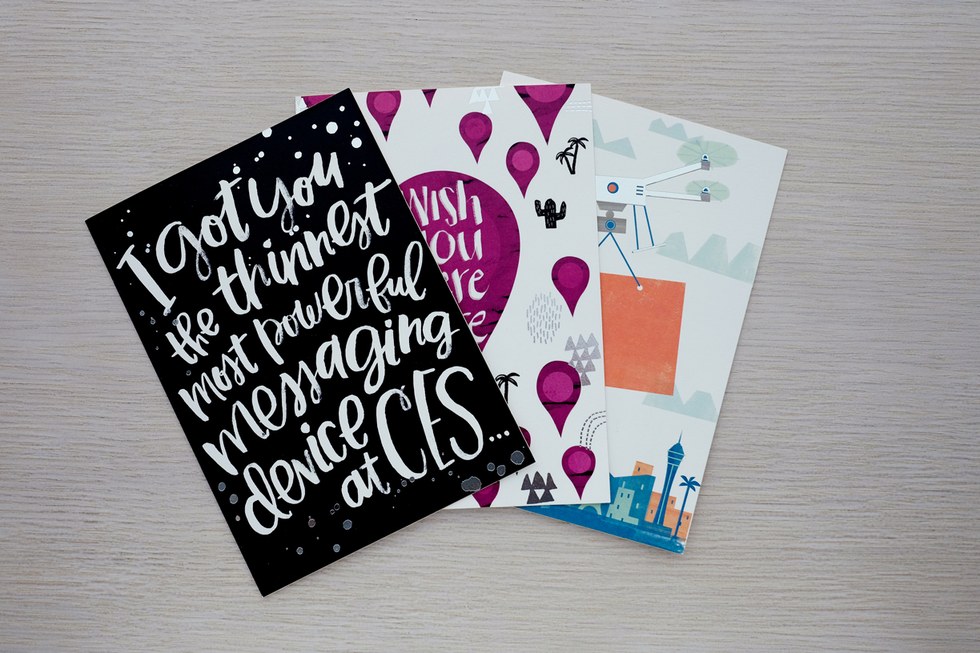Reading Time: About 3 minutes
One of the most talked about brands of this year’s International CES might surprise you. American Greetings launched a viral stunt campaign for a “device like no other”; a powerful “sentiment-delivery system” known as the greeting card. The brand enlisted Nick Offerman to be its ambassador, extolling the virtues of analog communications and hand-written expression.
It was a wise move by the brand, asserting relevance at a very unexpected venue with a clever and humorous message. But the idea behind it is much bigger than a one-time stunt. Human touch is disappearing from most of our communications and interactions. This is not only true for brands, where more and more purchase activity is occurring digitally, but also for humans, in general. Time and again I find myself counseling junior colleagues (and my own children) to skip the email and pick up the phone when they want to resolve a problem or connect with someone else. This direct and synchronous communication with others is increasingly rare.
This circumstance is increasing the value of direct mail. You read that right. Direct mail. Remember it? The “old marketing”, unsexy but highly measurable communications campaign tactic that was made supposedly obsolete by Mailchimp and Constant Contact. The trouble is that digital is now the default communications tactic, so your target has a bottomless inbox of unsolicited emails competing with your message. In this context, a physical letter is often more likely to be opened and even (gasp) read! Of course much of the success depends upon the content, the context and the creative. A physical letter that looks mass-produced, contains generic messaging content, and has little relevance to the target will still find the waste bin unopened.
Demand for analog experiences are rising. Kodak announced at CES that it is bringing back Ektachrome color reversal film, which had been discontinued in 2012 because of the brand-killing success of digital photography. Five years later and a whole new generation of amateur and professional shooters are demonstrating a growing interest in analog photography.
In the music industry, sales of vinyl records continue to grow. According to Nielsen, vinyl accounted for 2% of physical music sales in 2012. The share last year: 12%.
While digital products and services will continue to grow and shape our lives, there is still a lot of room for human touch and analog experience. More room, in fact, than most marketers contemplate. I will use one of my pet peeves as a case in point: the customer satisfaction survey.
Voice-of-the-customer programs have created significant value for nearly every company that has incorporated them. VOC is a smart way to track customer satisfaction and service excellence. Except when it’s not. The widespread success of VOC tactics is making them less effective. Consumers are inundated with follow-up surveys, requests for reviews, and road-blocking survey intercepts. The result: a steadily growing bounce rate.
That bounce rate is a self-inflicted wound. The consumer agrees to take the survey rating their last flight or hotel stay or visit to a store. But then the marketer over-reaches with question after question and requests to share on social media and … it’s just too much. For a growing share of consumers, this is a request that taxes them on their most valuable asset: time.
Contrast this with programs that include the human touch, or at least the perception of human touch. In December I stayed for the second time at The Edition hotel in Manhattan. I do not belong to any loyalty program at The Edition, yet when I got to my room there was a hand-written note from the hotel manager welcoming me back; a cookie accompanied the note. While not every brand has the capacity to exert this human touch, more do than choose to exercise it.
The human touch doesn’t have to be a physical or analog experience. You can express humanity in a digital touch, but it shouldn’t feel automated. We are beseiged by a proliferation of automated marketing touches that feel woefully impersonal and one-sided. Review us on Yelp! Share on Facebook! Use this coupon to get 10% off when you purchase in the next 24 hours! Contrast this approach with that of Dollar Shave Club (a brand I keep writing about because of its brilliantly personal human touch). DSC frequently sends its members free content they would want to read if they came across it on the net. The brand sends emails thanking customers without any request for a quid pro quo response. The result is a feeling of oneness with the brand, and particularly its very charismatic founder and CEO Michael Dubin.
So while it may seem odd that American Greetings showcased the power of paper at the world’s biggest technology event, the truth is that analog and digital go quite well together. Audiophiles and shutterbugs profess that the analog equivalents of music and photography, respectively, are better because of their imperfections—imperfections that bring out the humanness in the product. We humans are social animals (even the most introverted of us) that respond in amazing ways to human touch. The brands that will continue to win our hearts and minds are the ones who recognize this fact.

